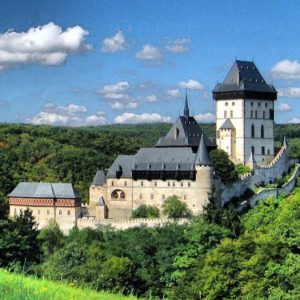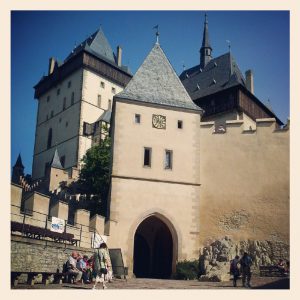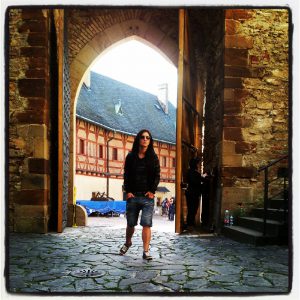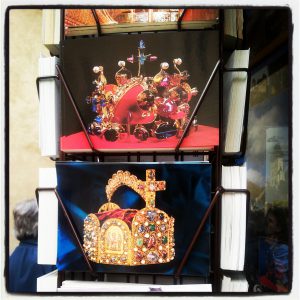Karlštejn Castle
By Tracy A. Burns
 History
History
Only a 40-minute, scenic train ride from Prague, Karlštejn Castle looms over a picturesque village with a steep, narrow road leading to the Gothic lover’s paradise. The imposing structure, built for Bohemian King and Holy Roman Emperor Charles IV in 1348, housed the crown jewels of the Holy Roman Empire until 1420. Charles IV also kept his own personal relics and the Bohemian royal insignia here. The fortress-like place served as the emperor’s summer retreat, too. Over 660 years old, the castle was never totally conquered. It even survived a seven-month siege by the Hussites during the Hussite wars that pitted the Radical Hussites against the Holy Roman Empire and others in the 15th century.
Karlštejn Castle Tours
 Karlštejn offers two tours. The first lasts 50 minutes and gives an overview of the castle during its Gothic days while the second, which must be reserved in advance, almost brings the Middle Ages to life with its frescoes, paintings, and statuary during an hour and a half. This tour includes a visit to the 14th-century Chapel of the Holy Cross, which underwent a 20-year renovation from 1981 to 2000. Visitors can see three sections of the castle – the Imperial Palace, Marian Tower, and the Great Tower.
Karlštejn offers two tours. The first lasts 50 minutes and gives an overview of the castle during its Gothic days while the second, which must be reserved in advance, almost brings the Middle Ages to life with its frescoes, paintings, and statuary during an hour and a half. This tour includes a visit to the 14th-century Chapel of the Holy Cross, which underwent a 20-year renovation from 1981 to 2000. Visitors can see three sections of the castle – the Imperial Palace, Marian Tower, and the Great Tower.
Tour I
 In the first room of tour number one, a large, colorful map of the Holy Roman Empire during Charles IV’s reign shows that Luxembourg and even Berlin had been at that time part of the Czech kingdom. While both tours focus on the Gothic, there are other architectural styles represented. A 17th-century ornate wardrobe with exquisite engravings stands in the room where the bodyguards used to live. In another space on the first tour, parts of a wooden bed, also with stunning engravings, date from the 13th, 16th, and 19th centuries. On the walls surrounding the bed hangs a green with gold fabric that shows phoenixes and other mythological creatures.
In the first room of tour number one, a large, colorful map of the Holy Roman Empire during Charles IV’s reign shows that Luxembourg and even Berlin had been at that time part of the Czech kingdom. While both tours focus on the Gothic, there are other architectural styles represented. A 17th-century ornate wardrobe with exquisite engravings stands in the room where the bodyguards used to live. In another space on the first tour, parts of a wooden bed, also with stunning engravings, date from the 13th, 16th, and 19th centuries. On the walls surrounding the bed hangs a green with gold fabric that shows phoenixes and other mythological creatures.
Objects dedicated to Saint Catherine of Alexandria pop up during both tours because Charles IV won his first battle on Saint Catherine of Alexandria’s name day. A statue of Saint Catherine of Alexandria hails from the end of the 14th century. Donning fluttering, white drapery, she stands on the pagan Roman Emperor Maxentius’ head. She tried to persuade him not to punish Christians, so he had her beheaded.
In Charles IV’s personal chapel to Saint Wenceslas, there is a 14th-century portable altar full of vibrant colors as well as an alabaster statue of the Virgin Mary from France. In the Throne Room, the 14th-century ceiling is composed of dark green squares with wooden frames. A gold ball decorates the middle of each square. The throne, a 19th-century copy, is situated between two windows because Charles IV liked to be in shadow so no one could see his facial expressions or read his emotions.
The Hall of Forebears features large portraits of the emperor’s ancestors, members of the Přemyslid dynasty. The only woman represented is the fictive Libuše, who, according to legend, married a poor farmer in the Přemyslid family, and founded both the first Přemyslid dynasty and Prague. Saint Wenceslas is there, too, pictured with a black eagle. Next to him is his brother Boleslav the Cruel, who assassinated him. The first painting with Karlštejn in the background is a portrait of a bearded Charles IV donning a red and golden crown. It hails from the 16th century. Objects in other rooms include a painting of Wenceslas learning to read and a display of priests’ robes, embroidered with silver and gold and dating from the 16th century. Jewels from the 14th to 19th centuries grace one display case. Take a good look at the white gem. It dates back to the third century AD. Wall panels with semi-precious stones on a gold background are decorated with the letter “K” for Karel, which means Charles in Czech. A stunning copy of the crown of the Holy Roman Empire contains a thousand pearls and weighs two and a half kilos.
Tour II
 While the first tour informs, it is the second that astounds and amazes. The Church of the Assumption of the Virgin Mary is enthralling with its beautiful, though well-worn, 14th-century frescoes showing the Apocalypse. Almost half of the frescoes were destroyed in the Renaissance renovation of the castle, though. The last fresco in the group depicts the Virgin Mary holding Christ as the sun’s rays envelop them after they have been chased by a dragon. There are also frescoes of Charles IV, created during the emperor’s lifetime. In one of them, the emperor is putting pieces of the True Cross into a golden reliquary cross sporting yellow and white robes. A sanctuary in the wall holds a sculpture of Our Lady, made by Peter Parler (Petr Parléř), the German architect who constructed the Charles Bridge and Saint Vitus Cathedral in Prague. Some say the face of the statue was modeled after Charles IV’s third wife, Anna, who is probably holding her son, Wenceslas IV. A golden cross on a wall near a window is made of semi-precious stones. The cramped Chapel of Saint Catherine next door is decorated with exquisite frescoes, one showing Christ on a cross, a golden halo above his head. Semi-precious stones adorn the walls.
While the first tour informs, it is the second that astounds and amazes. The Church of the Assumption of the Virgin Mary is enthralling with its beautiful, though well-worn, 14th-century frescoes showing the Apocalypse. Almost half of the frescoes were destroyed in the Renaissance renovation of the castle, though. The last fresco in the group depicts the Virgin Mary holding Christ as the sun’s rays envelop them after they have been chased by a dragon. There are also frescoes of Charles IV, created during the emperor’s lifetime. In one of them, the emperor is putting pieces of the True Cross into a golden reliquary cross sporting yellow and white robes. A sanctuary in the wall holds a sculpture of Our Lady, made by Peter Parler (Petr Parléř), the German architect who constructed the Charles Bridge and Saint Vitus Cathedral in Prague. Some say the face of the statue was modeled after Charles IV’s third wife, Anna, who is probably holding her son, Wenceslas IV. A golden cross on a wall near a window is made of semi-precious stones. The cramped Chapel of Saint Catherine next door is decorated with exquisite frescoes, one showing Christ on a cross, a golden halo above his head. Semi-precious stones adorn the walls.
Ascending the Great Tower, the visitor is engulfed in Gothic frescoes. Those seen on the two walls narrate legends about Saint Wenceslas and the story of Saint Ludmilla while on the ceiling about 40 angels play celestial music, each on a different instrument. The Chapel of the Holy Cross, on the Great Tower’s second floor, proves to be the masterpiece of all masterpieces. The space is sure to dazzle the visitor with its rich and ornate decoration. In this room designed by the sovereign Charles IV, semi-precious stones line the walls as do 129 painted panel paintings of saints, popes, knights, emperors, martyrs, kings, the Apostles, and others. The creator of the panels is none other than the legendary Master Theodoric, Charles IV’s court painter. Roman emperor Charlemagne is clad in red and holds a golden orb. His shield of a double-headed black eagle juts out slightly from the wall. Saint Wenceslas is present, too, gripping a golden orb and protected by a shield with a silver eagle. Try to find Saint Jerome, who translated the Bible into Latin, or look for the only African saint, Maurice. Saint Peter grips a key, white Saint Andrew has a cross and Saint Paul wields a sword. Behind a gilded gate, a panel shows Jesus Christ on the cross. The gold ceiling is perhaps even more spectacular than the wall paintings. It is decorated with thousands of stars made out of Venetian glass.
That’s by no means all there is to see at Karlštejn. Visitors can climb the Great Tower, go to an archeological exhibition in the former prison, peer at a 14th-century well that is 80 meters deep, or enjoy the scenic views from the ramparts.
A tribute to the reign of Charles IV, Karlštejn has played a significant role in the history of the Czech nation. And now tourists can see that role for themselves.



